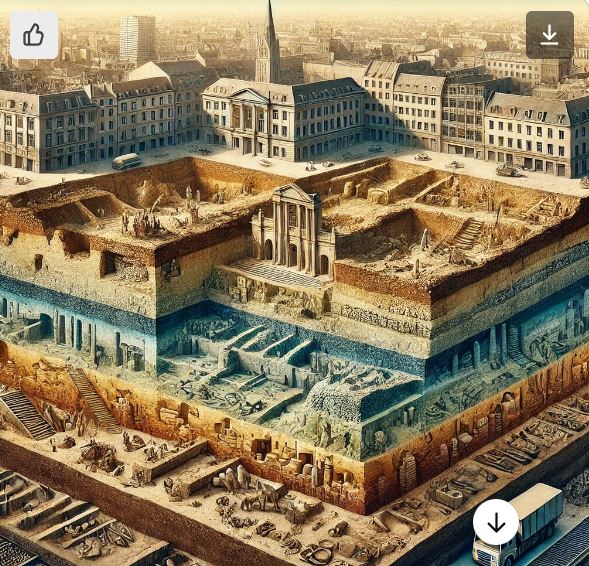I am putting together some resources for various projects, but one is on landscapes, with links to the urban landscape in particular. It explores how successive periods of history in a city leave some traces of the past, but most of them are hidden, or removed in the process of regeneration. Sometimes the facade of a historic building may be retained, but the rest replaced by a modern building which will probably have been built with materials which will not outlast the original facade.
I have included reference to the term palimpsest.
This is a word I use when discussing urban change, and it needs some explanation when it is first introduced.
I'd like an image to represent the idea of a palimpsest.
These were the first two attempts that ChatGPT / Dall-E made at creating an image representing an urban palimpsest from my prompts... certainly interesting... a bit Metropolis inspired...
- Uneven Pavements: Variations in pavement materials or patterns can indicate where old streets or pathways used to be, often revealing older layouts beneath modern developments.
- Ghost Signs: Faded advertisements painted on buildings, often uncovered during renovations, showcasing past businesses or products that have long since disappeared.
- Architectural Anomalies: Buildings that have been remodeled or added onto, revealing mismatched brickwork or differing styles that indicate the age and evolution of the structure.
- Altered Windows and Doors: Bricked-up windows or doors that suggest the original layout of a building or its purpose in a different era.
- Beneath the Surface: Occasionally, remnants of old infrastructure like cobblestones or remnants of former railways can be found beneath modern road surfaces.
- Old Street Names: Streets that have been renamed but may still retain the old names in plaques, signs, or even on maps from previous decades.
- Hidden Courtyards: Narrow alleyways or hidden courtyards that were once bustling spaces but are now quiet, hinting at the city’s social evolution.
- Basements and Cellars: Many modern buildings have basements that were originally designed for different purposes, like storage or workshops, echoing the city’s industrial history.
- Historical Markers: Discreet plaques or stones indicating historical events or significant figures tied to the location, often overlooked by passersby.
- Old Utility Covers: Manhole covers or utility access points marked with old company logos or designs, showcasing a city’s industrial legacy.
- Eroded Foundations: Exposed sections of old walls or foundations from earlier buildings, sometimes visible in park areas or during construction.
- Public Artwork: Murals or sculptures that reference historical events or figures, offering a glimpse into the city’s cultural past.
These hidden signs might require a keen eye to spot but can contribute to the rich narrative of a city’s evolution over time.


Comments